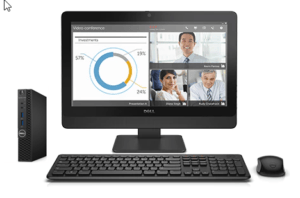Nitty-Gritty PC Spec
 Nitty-Gritty PC Spec: a reader asks…
Nitty-Gritty PC Spec: a reader asks…
Can you give me a brief rundown on what specs I should be going for when buying a new desktop PC? Nothing special, no gaming, video or other high-end work. I do have large music and photo libraries.
Ok, here’s the nitty-gritty: Get Windows 10, get 16gb of RAM, get the largest solid-state drive (SSD) you are willing to pay for, and get the largest screen size that fits your situation – preferably 1080p or better connected with either HDMI, DisplayPort, or DVI-D. Done!
Well that was perhaps too brief, let me expand in a few ways. First, looking at brand names, I’d stick with Lenovo or Dell. They’re the best of the big players. They both have plenty of models to choose from, from the microPC of the Dell Omniplex 3000/7000 series, to the mid-size towers of either brand. Hint, you don’t need a big CPU unit in most cases.
Next, let’s examine why I recommend those specs. With Windows 10 and your average user’s usage pattern, 16gb is prudent. Most of us these days have several apps open at the same time, and perhaps a half-dozen or more browser tabs. So 8gb of RAM is just not quite enough. An SSD is going to be screamingly fast compared to the old-style spinning hard drives, but make sure yours is big enough to fit your libraries and some room for them to grow.
 The screen size is based on your budget and your available space – you don’t say your age, but, as we age (sic), our eyes do much better with larger screen sizes. You might even decide to get two screens! Hint, once you’ve gone multi-screen it’s frustrating to use only one. And any digital connection type is going to be loads better than an analog (e.g., VGA) connection.
The screen size is based on your budget and your available space – you don’t say your age, but, as we age (sic), our eyes do much better with larger screen sizes. You might even decide to get two screens! Hint, once you’ve gone multi-screen it’s frustrating to use only one. And any digital connection type is going to be loads better than an analog (e.g., VGA) connection.
Lastly, don’t even think about Windows 7, 8, or 8.1. Get Windows 10. Just do it. For all its foibles, it’s still the best, most stable and most safe Windows platform. Even the built-in antivirus (Windows Defender) works pretty well.
This website runs on a patronage model. If you find my answers of value, please consider supporting me by sending any dollar amount via:
or by mailing a check/cash to PosiTek.net LLC 1934 Old Gallows Road, Suite 350, Tysons Corner VA 22182. I am not a non-profit, but your support helps me to continue delivering advice and consumer technology support to the public. Thanks!








Hi Chris,
I’d be interested in learning more about why 2 scenes are better than one. In what circumstances would you use two screens? I have only once done so: while running a “how to” tech video on my iPad while applying the lesson on the desktop screen. But are there routine uses simultaneous use of two screens?
Hi Mary Lou, thanks for your question! I think the most common way folks use dual screens is by having one screen showing their email app, and then using the other screen for their web browser window. That way they can switch between two apps without having to shrink windows or play the ’tiling game’ in sizing and placing windows, perhaps with some overlap (one window doesn’t quite cover the other window so you can click on a corner to switch back and forth between windows).
If the screens are big enough, you could also fit a utility or two on the same screen as the main app, again without them overlapping. Such as the calculator (if you often do math), or a note-taking app (such as Notes, Evernote, or MS OneNote).
This points to the big advantage of being able to see more without having to move windows around. Since our computers are great at multi-tasking (us humans, no so…), it makes it easier for us to quickly switch from one task to another.